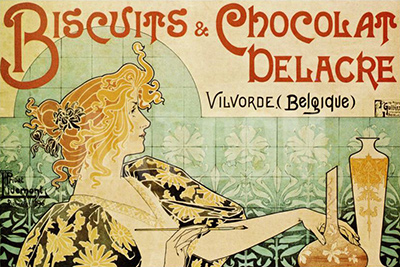By the 1890s, the French capital (Paris) was decorated with a new visual culture: advertising posters.
The implementation of the Law on 'Freedom of the Press' in 1881 meant that the only official place for posting posters and adverts was the Paris Hoardings. However, the advancement in (and increasing affordability of) print technology, resulted in the Paris Hoardings being transformed into street galleries where artists would display, auction and compete with each other in a race to produce posters and art of the highest quality. As well as cultural events and representations of fin-de-siècle Paris, Mucha's paintings illustrated modern life and transport in twentieth century France. In addition to his commissions for magazine illustrations, he was also hired to illustrate poster adverts for biscuits and chocolate Delcare, bicycles, perfume and cigarette papers.
These adverts were for a diverse range companies, who all wanted to exploit the new paper printing and colour lithography technologies to publicise their goods. Mucha began to use a distinct design style for his adverts for consumer products (based on his Gismonda): a single female or bust and head of a seductive female who is prominent against a backdrop of flora and fauna. Mucha recognised that consumers would be more likely to connect with a product (in this case, Biscuits and Chocolate Delcare), if the poster was eye-catching and advertised by an attractive model: this was one of the first examples of companies using the female figure and sensuality to market and also promote biscuits and chocolate by sending an alluring message about the product to potential customers.
This revolutionary advertising style contrasted with the modest and ‘prim and proper’ attitudes at the time towards sex and nudity. It could be argued that Mucha’s use of the female form marked a crucial point on the evolutionary timeline for the advertising industry, and society’s attitudes towards women.




